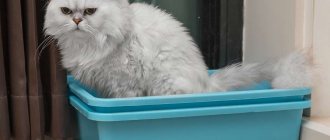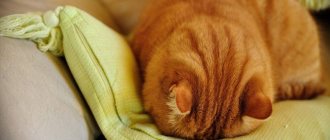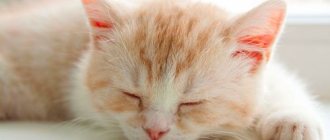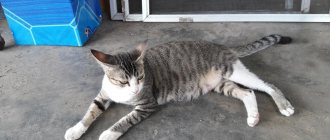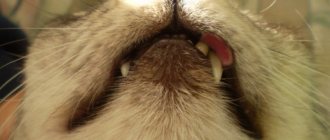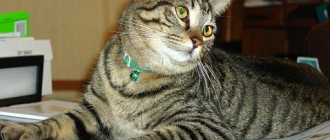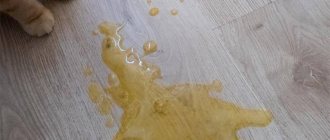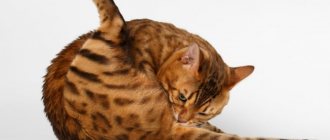Save article:
Dental disease in cats is not taken seriously by many owners until it is too late. Quite often, the reason for this is that in the initial stages, most of the described ailments do not bother pets. Owners should be attentive to any manifestations of oral disease in cats, as even simple plaque can lead to tooth loss. In addition, if left untreated, the likelihood that nearby organs will be affected increases, which can lead to serious complications.
Dental diseases include not only problems with enamel, but also various inflammatory processes and pathologies affecting the mucous membrane of the mouth, salivary glands, bones and nerves. This group of oral diseases in cats has no age, breed or gender restrictions, although it is more common in old or weakened animals.
It should be remembered that the clinical picture of many oral diseases in cats is similar and only an experienced veterinarian will be able to figure out whether the disease is independent or a secondary symptom indicating other malfunctions of the body.
global $ads_google; //data-ad-slot=”2475549904″ $ads_google = empty($ads_google) ? false : true; ?> if ($ads_google == false) {?>
$ads_google = true; ?> } ?>
Oral diseases in cats
The described group of pathologies can be divided into several types:
- causes of appearance (trauma, virus, infection, fungus);
- nature of the defect (superficial, deep, neoplasm);
- areas of impact (gums, tooth tissue and/or bones, nerves).
The problem is that there can be more than one reason at a time. For example, deviations in the shape of the teeth in the Persian cat breed are caused by a genetic factor, which is often a pretext for the development of various inflammatory processes, especially with improper oral care. Accordingly, the nature of the manifestation often depends not only on the breed of the animal, but also on age, concomitant diseases, and other things.
as a classification of oral diseases in cats , since there is no strict distinction.
Cat's dental system
The organization of the animal's dental system has its own distinctive features. It consists of the following teeth:
- incisors – located in front, with their help the pet captures prey;
- fangs - designed for tearing prey;
- premolars - used for chewing food;
- Molar teeth - designed for crushing food.
From birth, animals have no teeth. After about two weeks, the first incisors appear, followed by fangs and root teeth. Teeth erupt approximately until the end of the first month of life. In total, a cat has 26 baby teeth - 14 at the top and 12 at the bottom.
Between four and eight months, baby teeth are replaced by permanent teeth. During the same period, 4 more teeth grow. In total, an adult animal has 30 teeth - 16 at the top and 14 at the bottom.
Dental diseases in cats
Despite the large number of variants of oral diseases in cats, the most common are:
- tartar
. They are characterized by a gray-yellow-green coating consisting of saliva, food debris, dead mucosal cells and microbes. The formation begins from the edge of the gum, gradually moving to the crown, and then to the entire tooth, with virtually no effect on its tissue. The effect is only on the mucous membranes;
- caries
. It manifests itself in the form of destruction of hard dental tissues with the formation of cavities. Depending on the location of the defect, it can be superficial, medium, deep, or complete. The exact causes of caries have not been established. The most probable are considered to be insufficient enamel hardness and tooth fractures; - periodontitis (periodontal disease)
. Most often it is diagnosed in cats of British, Abyssinian, Bengal and similar breeds, starting from the age of one year. Characterized by inflammation of the gums. In severe cases, it can lead to kidney diseases, spread of infection to the larynx, palatine tonsils. The disease progresses quite quickly and leads to complete loss of teeth.
The main cause of almost all dental diseases in cats is the lack of hygienic oral care.
The following factors influencing the development of pathogenic bacteria are considered: soft food, dental imbalance, metabolism, enamel damage. Genetic predisposition is also common.
What Causes Dental Disease?
Plaque, a colorless film on your cat's teeth, is the cause of bad breath and gum disease. Because your cat doesn't brush its teeth in the morning like you do, this plaque can lead to tartar formation. The result is swelling, redness and inflammation of the gums, or in other words, gingivitis. If not checked regularly, your pet may develop periodontal disease, which destroys the gums and the tissue that supports the teeth.
Certain factors influence the occurrence of dental problems. This:
Age: Dental disease is more common in older cats.
Food: Eating sticky cat food can cause plaque to form more quickly.
Dental disease can be prevented and treated in most cats. Keeping your pet's teeth and gums clean and healthy is not difficult at all. The first step is to ask your veterinarian about professional dental cleaning routines. Next, find out how often you should brush your cat's teeth (yes, you can do this at home).
Symptoms of dental diseases in cats
Owners of domestic predators should remember to take responsibility for their pets and pay attention to the slightest signs of illness. This is what will allow timely detection of many of the oral diseases in cats, which in turn will reduce the risk of tooth loss and the appearance of other serious diseases or complications associated with inflammatory processes.
The main symptoms to watch out for are:
- smell from an animal's mouth;
- loss of appetite, refusal of solid food;
- the presence of blood in saliva and/or its appearance when pressing on the gums;
- any changes in the oral cavity (ulcers, plaque, chipped teeth, inflammation and redness of the mucous membrane).
Each of these indicators can indicate a number of ailments that are not related to dental diseases in a cat , but together they help in making a diagnosis. In addition, you should be attentive to changes in your pet’s behavior, especially if it is accompanied by the animal’s obsessive attempts to get its paw into its mouth or regular rubbing of its muzzle against any objects that come along.
When does a cat need a dentist?
Most cats experience dental problems at some point. And here's how you can help them.
Over the course of its life, a cat grows two rows of teeth. The first set consists of 26 teeth, otherwise known as baby teeth. They begin to appear when the kitten is about four weeks old, and by six weeks or so, the full set is present. By the time a kitten is about six months old, the baby teeth will have fallen out and will be replaced by 30 permanent teeth - specially designed by Mother Nature for catching prey, tearing it apart and chewing it. They are also useful for self-defense.
The term "permanent", however, is not entirely accurate, as a significant portion of the adult cat population will eventually lose one or more of their teeth due to injury or disease. According to veterinary dentists, only about 10 percent of cats will be able to live their lives without experiencing any dental problems. And in many cases, the problem can only be resolved by removing the affected tooth, if there are not very many of them.
Nature and nurture
To some extent, dentists say, genetics plays a role in determining which cats are more susceptible to dental disease, pointing out that certain purebred breeds, such as Abyssinians, Siamese, Maine Coons, Persians and Somalis, tend to be the most susceptible. risk. But the main cause of dental problems can be traced to the diet of modern cats.
The cat is a carnivore. His teeth must be strong and clean when he chews the meat and bones of birds, rodents and other predators. Today the cat lives mainly on a diet of porridge, which we feed it. And by doing so, we are unintentionally creating serious dental problems for our cats.
Common dental diseases in cats
Four types of feline dental disease account for the vast majority of problems for which the removal of one or more teeth may be the only cure:
Periodontitis is the most common disease, affecting an estimated 85 percent of cats over six years of age. With this disease, layers of plaque accumulate and harden on the surface of the tooth. Bacterial toxins and enzymes from plaque eventually cause an inflammatory reaction in the gums (gums), which, if left untreated, leads to severe gum inflammation (gingivitis). In cats, advanced periodontal disease can rapidly progress to an end stage for which tooth extraction is the only reasonable treatment option.
Feline odontoclastic resorptive lesions (FORL) are another relatively common dental disease, affecting approximately 50% of cats. This disease is characterized by lesions caused by plaque that begins in the bone tissue (dentine) just below the enamel. Due to an inadequate immune system response, the tissue is unable to repair itself and damage can progress rapidly and damage the tooth and its root irreparably. According to Dr. Carmichael, any tooth in which the FORL has expanded to the point where the damage poses a threat to the pulp chamber should be removed.
Feline gingivitis/stomatitis syndrome (FGS) is a relatively rare disease, affecting approximately one in 100 cats, most commonly among those with feline leukemia virus (FeLV), feline immunodeficiency virus (FIV), or other viral, nutritional, or hormonal diseases. Although antibiotics and steroid therapy may be helpful in some cases, removal of most or all teeth may be the only treatment option.
Tooth fracture can occur as a result of trauma or, less commonly, as a result of chewing. Inaction, dentists warn, leaves a broken tooth painful and can lead to infection. The extraction thus serves the purposes of relieving the affected cat's pain and preventing infection.
Signs that a cat is suffering from dental problems, says Dr. Carmichael, include bad breath, red and swollen gums, the cat manipulating the cat's paw in the mouth, and refusing solid food. But cats are unlikely to show that they are in pain: cats are descended from wild animals, and it is very deep in them that if they show weakness, they themselves can become prey.
Problem solving
The only way to “really find out what's going on” in a cat's mouth, veterinary dentists assure, is to examine the animal's teeth under general anesthesia and, if necessary, take an x-ray. The cat is usually sedated for as long as necessary for teeth cleaning, examination, and treatment as needed. If extraction is necessary, the procedure may take 45 minutes to an hour.
Surgical removal
If the tooth is not so damaged that it is ready to fall out, dentists remove the tooth through surgical removal. “We never just pull out a tooth,” they explain. “Rather, we lift the gum tissue from the outside of the tooth and use a powerful, water-cooled drill to remove some of the bone tissue that holds the tooth in place in the mouth. We then use special instruments to remove the tooth and stitch the gums back together with absorbable suture material. - Any licensed veterinarian can clean, examine and remove teeth.
Shortly after extraction, he says, the cat wakes up and goes home with a few days' supply of painkillers. One thing we can guarantee is that your cat will never grieve over a tooth that has been removed. She will feel better, eat better, and live better overall without him.
Treatment of dental diseases in cats
In most cases, timely access to a veterinary clinic contributes to the best results in the treatment of many dental diseases in cats. Otherwise, there is a high probability of the situation worsening (spread of infection to nearby organs, becoming chronic), which can lead to death (blood poisoning).
It should be remembered that there is no universal remedy, and the treatment of oral diseases in cats largely depends on the nature of the manifestations, causes and symptoms of the development of the clinical picture. A competent veterinarian takes into account all circumstances and adjusts prescriptions in a timely manner.
Pet owners should be prepared for the fact that often oral disease in cats requires radical measures to remove both the diseased tooth and those next to it. In this case, cosmetic dentistry can help, although animals quickly adapt and do not experience discomfort with a properly selected diet.
global $ads_google; //data-ad-slot=”2475549904″ $ads_google = empty($ads_google) ? false : true; ?> if ($ads_google == false) {?>
$ads_google = true; ?> } ?>
As a preventative measure for almost any dental disease in cats, regular hygienic cleaning of the oral cavity can be recommended. Additionally, it is recommended to use specialized food, vitamin supplements or pastes that prevent the formation of plaque. Regular visits to the veterinary clinic will also be an undoubted advantage. The faster you respond to the appearance of any symptoms of dental disease in your cat, the greater the chance of saving the teeth.
Teeth and food
Diseases of teeth and gums are more common in cats that are fed canned food, minced meat and other soft or liquid foods. Tartar forms on the surface of non-functioning teeth, which is the cause of diseases that lead to tooth loss or the need for their removal.
The health of teeth and gums is promoted by feeding your cat large pieces of meat and dry food that need to be gnawed and chewed. All this is not only a good exercise for the teeth and a massage for the gums, reducing the likelihood of dental disease, but also a good workout for the jaws, helping to develop their power.
Prevention measures
It is optimal, of course, to accustom your cat to regular hygiene procedures. Fortunately, today there are all available means: both special brushes and toothpastes (human toothpastes are STRICTLY prohibited from being used for animal oral hygiene, as they may well be toxic to your pet). But, let's be honest, this approach is not always feasible. In this case, your task is to monitor the condition of your animal’s oral cavity and regularly undergo professional examinations. check-ups with your veterinary “pediatrician” and perform necessary dental procedures in a timely manner.
So, your home test, which should become regular:
- Breath. Of course, a cat's mouth shouldn't smell like roses, but the smell shouldn't be unpleasant and/or disgusting. If an abnormally strong unpleasant odor comes from the animal’s mouth, it should be shown to a veterinarian.
- Lips and gums. Pull the cat's head towards you and gently move her lips away, look at her gums. The gums should be firm and pink (NOT white, red, or swollen). The teeth should be clean and free of yellowish plaque, brownish tartar, and no broken or missing teeth.
- Bad signs: excessive drooling, cat scratching the mouth area.
- The cat's teeth are falling out.
- Obvious problems. The animal should absolutely not have: dark red lines along the gums, ulcers on the gums or tongue, or pus.
How is the treatment carried out?
Every cat owner must remember to keep their pet from getting sick, you need to keep its oral cavity in good condition. To do this, it is recommended to brush your teeth with ultrasound 2 times a year. The veterinary clinic provides such a service.
The doctor performs the necessary procedures for the cat under general anesthesia. There is no need to worry, since modern veterinary medicine guarantees the use of safe drugs that act painlessly on animals and will not harm even a small kitten. Treatment for cats also includes cleaning teeth and stones, polishing and removing them. If necessary, surgery for jaw injuries or a procedure such as prosthetics is performed.
During dental procedures, tartar is removed painlessly and safely, and the teeth themselves become whiter. For mechanical cleaning, special toothpastes and suitable tools are used. You can insert teeth into your pet using the implantation method. Dentures can be metal-ceramic or zirconium. Preparing an animal for such a complex procedure as dental prosthetics should be carried out in a veterinary hospital using analgesics.
When do you need a cat dentist?
Inflammatory processes in the mouth occur not only in people, but also in cats and kittens due to poor care and failure to comply with basic hygiene rules. Most gum diseases in felines can simply be prevented if you undergo timely examinations by a veterinary dentist in the clinic. If you have dogs and cats or a small kitten at home, you need to monitor factors such as the environment, proper nutrition and prevention. Frequent dental problems in pets include plaque or tartar, gingivitis or periodontitis, caries or injury. An urgent visit to the veterinary clinic is needed in the following cases:
- The color of the kitten’s tooth has changed or the root has become exposed.
- The cat refuses to eat.
- Viscous and viscous saliva mixed with pus and blood is released.
- The cat's face is swollen.
Prevention of disease development
In the wild, representatives of the cat family clean their teeth through mechanical action. Being a predator, wild cats eat cartilage and raw meat, and also live less than their domestic relatives.
Domestic cats manage to wear down their teeth throughout their lives; the load on the teeth is enormous, resulting in the formation of microcracks into which pathogenic bacterial microorganisms easily penetrate. This is what causes the formation of tartar, caries, osteomyelitis and other diseases.
Cat owners don't often think about taking good care of their pet's oral cavity, but in fact it is necessary. It is important to regularly inspect your pet's mouth to remove any stuck food particles. If there are minor changes in your pet’s gums or teeth, do not delay a visit to the veterinarian.
Proper organization of cat nutrition deserves special attention. It is necessary to take care of a balanced diet, selecting super-premium brands of food, periodically adding a line to prevent dental disease.
